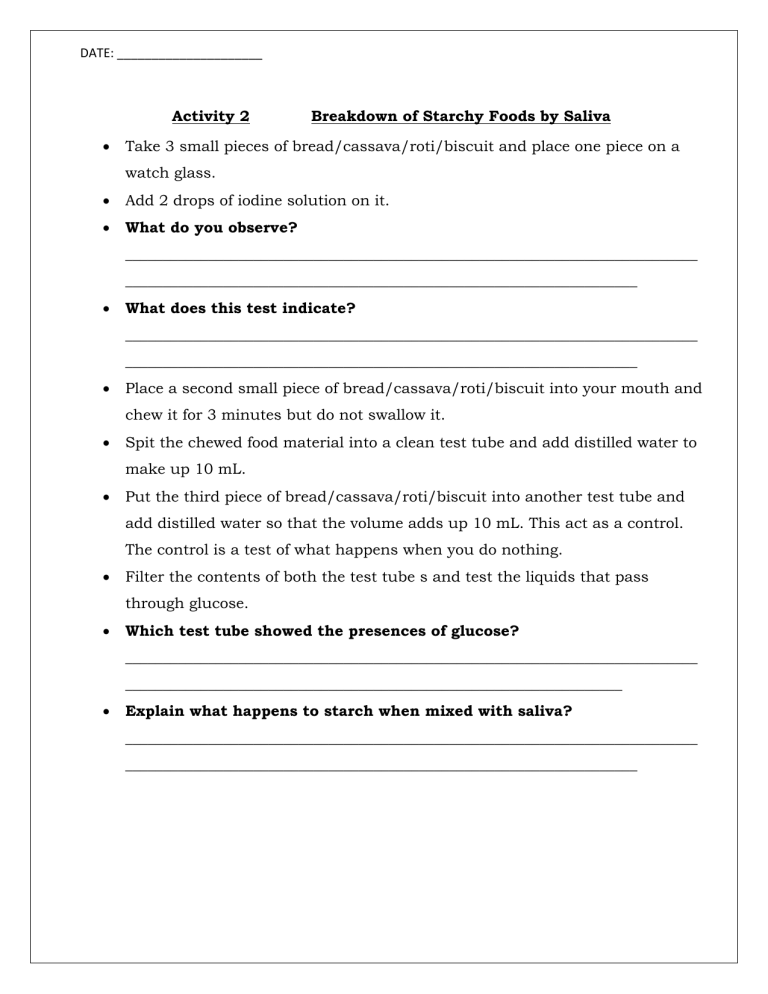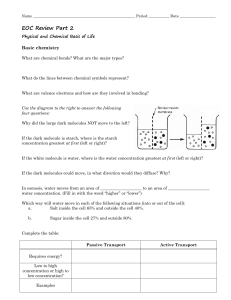
DATE: _____________________ Activity 2 Breakdown of Starchy Foods by Saliva Take 3 small pieces of bread/cassava/roti/biscuit and place one piece on a watch glass. Add 2 drops of iodine solution on it. What do you observe? ____________________________________________________________________________ ____________________________________________________________________ What does this test indicate? ____________________________________________________________________________ ____________________________________________________________________ Place a second small piece of bread/cassava/roti/biscuit into your mouth and chew it for 3 minutes but do not swallow it. Spit the chewed food material into a clean test tube and add distilled water to make up 10 mL. Put the third piece of bread/cassava/roti/biscuit into another test tube and add distilled water so that the volume adds up 10 mL. This act as a control. The control is a test of what happens when you do nothing. Filter the contents of both the test tube s and test the liquids that pass through glucose. Which test tube showed the presences of glucose? ____________________________________________________________________________ __________________________________________________________________ Explain what happens to starch when mixed with saliva? ____________________________________________________________________________ ____________________________________________________________________ DATE: _____________________ Model Gut Experiment Visking tubing is a material with extremely small holes in it, too small for us to see. It acts as a sieve, and allows only very small molecules to pass through it. Glucose molecules were able to pass through these holes, but starch molecules were unable to do so. This suggests that glucose molecules are smaller than starch molecules. The walls of your alimentary canal behave like visking tubing, and only allow small molecules to pass through them. The food that you eat must pass through the walls of the intestine so that it can go into your blood stream. However, most of the food you eat contains large complex molecules such as starch. These molecules are too big to pass through the walls your intestine into your blood vessels. In the intestine these large complex molecules are broken down into molecules small enough to pass through the walls. This breaking down process is called digestion. Materials Starch solution 30 cm visking tubing Cotton thread Glucose solution Test tube Method 1. Soak the visking tubing strip in water until it has softened. 2. Separate the sides of the tube by rubbing it between your fingers. It should form a tube. 3. Knot one end of the tube. Half fill the tube with the mixture of starch and glucose solution. 4. Knot the other end securely. Carefully rinse the outside of the tube with water. Put the tube in a test tube of water as shown in figure below. DATE: _____________________ 5. Remove a sample of water from the test tube and test for the presence of glucose and starch. The final result is shown in the figure below. (a) Which substance, starch or glucose, passed through the tubing? ______________ (b) What does this suggest about the walls of the tubing? __________________________________________________________________________ (c) Why are some molecules able to pass through and others not? __________________________________________________________________________ __________________________________________________________________________ (d) Which molecule do you think is larger – starch or glucose? _____________________ (e) What is the visking tubing similar to in our body? _________________________________________________




